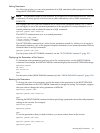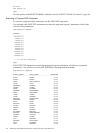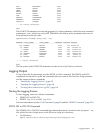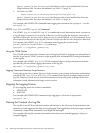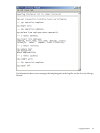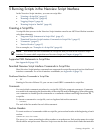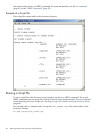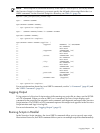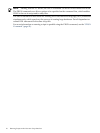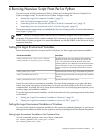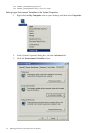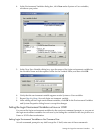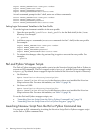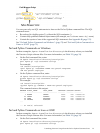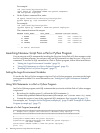
NOTE: If the script file is outside the directory of the hpnvs.cmd or hpnvs.sh file (by default,
the Neoview Script bin directory), you must specify the full path of the script file in the @ or
OBEY command. For the Neoview Script bin directory, see Table 2-1 (page 34).
SQL>@C:\ddl_scripts\sch_invent.sql
SQL>-- CREATE SCHEMA
SQL>CREATE SCHEMA INVENT;
--- SQL operation complete.
SQL>-- CREATE TABLES/VIEWS in SCHEMA INVENT
SQL>SET SCHEMA INVENT;
--- SQL operation complete.
SQL>CREATE TABLE INVENT.supplier (
+> suppnum NUMERIC (4) UNSIGNED
+> NO DEFAULT
+> NOT NULL
+> ,suppname CHARACTER (18)
+> NO DEFAULT
+> NOT NULL
+> ,street CHARACTER (22)
+> NO DEFAULT
+> NOT NULL
+> ,city CHARACTER (14)
+> NO DEFAULT
+> NOT NULL
+> ,state CHARACTER (12)
+> NO DEFAULT
+> NOT NULL
+> ,postcode CHARACTER (10)
+> NO DEFAULT
+> NOT NULL
+> ,PRIMARY KEY (suppnum)
+> );
--- SQL operation complete.
For more information about the @ and OBEY commands, see the “@ Command” (page 81) and
the “OBEY Command” (page 93).
Logging Output
To log output of a Neoview Script session while running one script file at a time, use the SPOOL
or LOG command. When you run an OBEY or @ command, Neoview Script displays each
command in the script file, the output for each command, and diagnostic messages in the Neoview
Script interface. The SPOOL or LOG command captures this output as it appears in the Neoview
Script interface and logs it in a log file.
For more information, see “Logging Output” (page 63).
Running Scripts in Parallel
In the Neoview Script interface, the @ and OBEY commands allow you to run only one script
file at a time. However, the PRUN command allows you to run multiple script files simultaneously.
Logging Output 69



